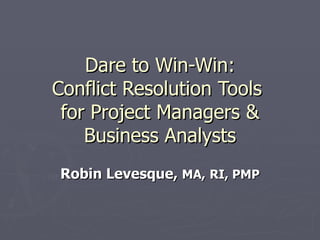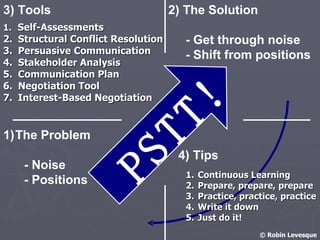Dare to Win-Win: Conflict Resolution Tools for Project Managers and Business Analysts
- 1. Dare to Win-Win: Conflict Resolution Tools for Project Managers & Business Analysts Robin Levesque, MA, RI, PMP
- 2. PM BA Sponsor Peers Team Customers Contractors Direct Reports Indirect Reports Advisor Sponsor ’s Peers Senior Leadership External Stakeholder Internal Stakeholder
- 3. Project Management Leadership Negotiation Communication © Robin Levesque
- 4. PSTT! 3) Tools 1) The Problem 2) The Solution 4) Tips © Robin Levesque
- 5. Communication Process Model Receiver Sender Form message Transmit Message Transmit Feedback Decode message Encode feedback Form feedback Encode message Decode feedback Receive encoded message Receive feedback Noise
- 6. Positions Villain Plot Victim Source: The Joy of Conflict Resolution, Gary Harper
- 7. "A strongly held belief, opinion, or attitude as to 'how it is' or 'how it should be'. An expectation that there is only one way, one right outcome, one correct solution. A belief that truth is absolute and that you are the holder of that truth." Daraan Parry, Warriors of the Heart
- 8. PSTT! 3) Tools The Problem - Noise - Positions 2) The Solution - Get through noise - Shift from positions 4) Tips © Robin Levesque
- 9. 1) Conflict Management Styles Assertiveness Cooperativeness Competing Collaborating Compromising Avoiding Accommodating High Low High Source: Thomas-Kilman Conflict Mode Instrument
- 10. Self Assessment Tools Thomas-Kilmann Conflict Mode Instrument Communicating Styles Survey by Dr. Paul P. Mok Parker Team Player Survey Now Discover Your Strengths by Marcus Buckingham and Donald O. Clifton Leadership Challenge LIP 360 by Kouzes & Posner
- 11. Sources of Conflict Incompatible goals Different values and beliefs Task interdependence Scarce resources Ambiguous rules Communication problems Resistance to change
- 12. 2) Structural Conflict Management Incompatible goals Different values and beliefs Task interdependence Scarce resources Ambiguous rules Communication problems Resistance to change Superordinate goals Reduce differentiation Reduce dependence Increase resources Clarify Improve communication Change management
- 13. 3) Persuasive Communication Audience Characteristics • Interests Demographics • Partners Communicator Characteristics • Credibility • A ppearence Communicator Medium Message Content • Key Messages Present all sides • Few arguments • Emotional appeals
- 14. Richness of Medium Richness Degree of Commitment and Involvement Awareness Newsletter Video Email Understanding Road shows Videoconferencing Intranet Support Seminars Forums Training courses Appraisals Involvement Feedback Forums Team Meetings 3 way communication Issue Brainstorming Q&A’s Commitment Team Problem Solving Task Groups Leadership Involvement Key Performance Indicators Focus Groups
- 15. 4) Stakeholder Analysis Low Interest High Low Power High I II III IV Keep Satisfied Keep Informed Manage Closely Monitor
- 16. 5) Communications Plan Matrix Activities Comm. Stakeholder Medium Timing Collect weekly status Project Leaders, Team Project Manager Status report, team review mtg, email Week Milestone Report Project Manager Sponsor, Steering, Stakeholders MS Project report, Review Mtg Month Information Bulletins Comm. Manager Stakeholders, Public Web Quarter Etc.
- 17. Stages Set the framework & establish a collaborative atmosphere Clarify & frame the issues Explore & build understanding Form agreement Justice Institute of BC Getting to Yes Separate the people from the problem Focus on interests, not positions Invent options for mutual gain Insist on using objective criteria Fisher, Ury & Patton Prepare to Negotiate Goals & Objectives Persuasive communication Know the “other side” Develop a strong BATNA Identify interests and potential solutions Getting Past No Go to the balcony Step to their side Reframe Build them a golden bridge Use power to educate Ury Toolkit Anger management Active listening Open questions Clarifying Acknowledging Reframing I statements Paraphrasing Empathizing Summarizing “ In business as in life, you don ’t get what you deserve, you get what you negotiate. ” Karrass Aspiration level Concession pattern Power exploitation Settlement time © Robin Levesque
- 18. Ěý
- 19. Ěý
- 20. 7) Getting To Yes Separate the people from the problem Focus on interests, not positions Invent options for mutual gain Insist on using objective criteria Fisher, Ury & Patton
- 21. Suggested Readings Getting to Yes , Ury, Fisher, Patton Getting Past No , Ury The Seven Strategies of Master Negotiators , McRae The Seven Strategies of Master Presenters , McRae, Brooks The Joy of Conflict Resolution , Harper Crucial Conversations , Patterson, Greny, McMillan, Switzler
- 22. PSTT! 3) Tools The Problem - Noise - Positions 2) The Solution - Get through noise - Shift from positions 4) Tips © Robin Levesque Self-Assessments Structural Conflict Resolution Persuasive Communication Stakeholder Analysis Communication Plan Negotiation Tool Interest-Based Negotiation Continuous Learning Prepare, prepare, prepare Practice, practice, practice Write it down Just do it!























